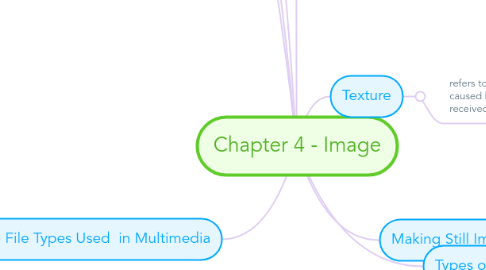
1. 3-D animation, drawing, and rendering tools include
1.1. Daz3D
1.2. Form*Z
1.3. NewTek′s Lightwave
1.4. Autodesk’s Maya
1.5. Trimble’s SketchUp
2. Features of a 3-D application
2.1. Modeling - Placing all the elements into 3-D space.
2.2. Extrusion - The shape of a plane surface extends some distance.
2.3. Lathing - A profile of the shape is rotated around a defined axis.
3. Rendering
3.1. Rendering - Use of intricate algorithms to apply user-specified effects
3.2. Takes many hours for a single image
4. Colors and Palettes in Multimedia
4.1. Understanding natural light and color models
4.1.1. Additive color
4.1.1.1. In the additive color method, a color is created by combining colored light sources in three primary colors - red, green, and blue (RGB).
4.1.2. Subtractive color
4.1.2.1. In the subtractive color method, color is created by combining colored media such as paints or ink.
4.1.2.2. The colored media absorb (or subtract) some parts of the color spectrum of light and reflect the others back to the eye.
4.1.3. Dithering
4.1.3.1. Usually, digitised images are 24 bit, 16 million colour depth.
4.1.3.2. If display system is limited to less than 16 million colours, the image must be transformed for display in the lesser colour environment (colour dithering).
5. Image File Types Used in Multimedia
5.1. Macintosh formats
5.1.1. On the Macintosh, the most commonly used format is PICT.
5.1.2. PICT is a versatile format developed by Apple.
5.2. Windows formats
5.2.1. The most commonly used image file format on Windows is DIB, also known as BMP.
5.2.2. DIB stands for device-independent bitmaps
5.3. Cross-platform formats
5.3.1. JPEG, GIF, and PNG – Most commonly used format on the Web
5.4. JPEG(Joint Photographic Expert Group )
5.4.1. Commonly used standard method of compression for photographic images.
5.4.2. Support a maximum of 16.7 million colors
5.4.3. Lossy compression technique: Losses some image information.
5.4.4. Degradation of image possible with repeated editing and saving
5.4.5. No transparency
5.4.6. No animation
5.5. GIF
5.5.1. 8-bit per pixel, bitmap image format commonly used by the world wide web.
5.5.2. Uses lossless compression technique.
5.5.3. Image can have transparent portion.
5.5.4. Animation possible.
5.6. PNG (Portable Network Graphic )
5.6.1. Supports more than 16.7 million colors.
5.6.2. Use Lossless Compression Technique
5.6.3. Image can have transparent portion
5.6.4. No animation
5.7. Image File Compression
5.7.1. lossless compression-every single bit of data that was originally in the file remains after the file is uncompressed. All of the information is completely restored
5.7.2. Lossy compression -reduces a file by permanently eliminating certain information, especially redundant information.
6. Making Still Images
6.1. Still images may be the most important element of a multimedia project.
6.2. Still images may be small or large, or even full screen. They may be colored, placed at random on the screen, evenly geometric, or oddly shaped.
6.3. Still images are generated in two ways:
6.3.1. Bitmaps (raster)
6.3.2. Vector-drawn graphics
6.4. Bitmaps editors are called painting program, vector editors are called drawing program
6.5. Image editing programs enable the user to
6.5.1. Enhance and make composite images
6.5.2. Alter and distort images
6.5.3. Add and delete elements
7. Types of Graphic
7.1. Bitmap graphics
7.1.1. Bitmap is derived from the words “bit,” which means the simplest element in digital world, an electronic digit that is either on or off, black or white, or true (1) or false (0).
7.1.2. Advantages -Can have different textures on the drawings; detailed and comprehensive.
7.1.3. Disadvantages -Large file size -Not easy to make modification to objects/drawings
7.2. Vector graphics
7.2.1. Applications of vector-drawn object
7.2.2. How vector-drawn images work
7.2.3. Vector-drawn images versus bitmaps
7.2.4. Vector-drawn images are used in the following areas
7.2.4.1. Computer-aided design (CAD) programs needed by architects and engineers
7.2.4.2. Graphic artists designing for the print media
7.2.4.3. 3-D animation programs – changes of position, rotation, and shading of light
7.2.5. How vector-drawn images work
7.2.5.1. A vector is a line that is described by the location of its two endpoints.
7.2.5.2. Vector drawing makes use of Cartesian coordinates.
7.2.6. Advantages -Vector images use less memory space.
7.2.7. Disadvantages -Objects/drawings cannot have texture. -cannot be used for photorealistic images.

